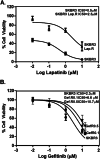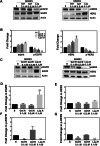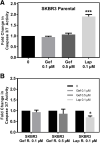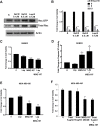Rac inhibition as a novel therapeutic strategy for EGFR/HER2 targeted therapy resistant breast cancer
- PMID: 34074257
- PMCID: PMC8170972
- DOI: 10.1186/s12885-021-08366-7
Rac inhibition as a novel therapeutic strategy for EGFR/HER2 targeted therapy resistant breast cancer
Abstract
Background: Even though targeted therapies are available for cancers expressing oncogenic epidermal growth receptor (EGFR) and (or) human EGFR2 (HER2), acquired or intrinsic resistance often confounds therapy success. Common mechanisms of therapy resistance involve activating receptor point mutations and (or) upregulation of signaling downstream of EGFR/HER2 to Akt and (or) mitogen activated protein kinase (MAPK) pathways. However, additional pathways of resistance may exist thus, confounding successful therapy.
Methods: To determine novel mechanisms of EGFR/HER2 therapy resistance in breast cancer, gefitinib or lapatinib resistant variants were created from SKBR3 breast cancer cells. Syngenic therapy sensitive and resistant SKBR3 variants were characterized for mechanisms of resistance by mammosphere assays, viability assays, and western blotting for total and phospho proteins.
Results: Gefitinib and lapatinib treatments reduced mammosphere formation in the sensitive cells, but not in the therapy resistant variants, indicating enhanced mesenchymal and cancer stem cell-like characteristics in therapy resistant cells. The therapy resistant variants did not show significant changes in known therapy resistant pathways of AKT and MAPK activities downstream of EGFR/HER2. However, these cells exhibited elevated expression and activation of the small GTPase Rac, which is a pivotal intermediate of GFR signaling in EMT and metastasis. Therefore, the potential of the Rac inhibitors EHop-016 and MBQ-167 to overcome therapy resistance was tested, and found to inhibit viability and induce apoptosis of therapy resistant cells.
Conclusions: Rac inhibition may represent a viable strategy for treatment of EGFR/HER2 targeted therapy resistant breast cancer.
Keywords: Breast cancer; EHop-016; MBQ-167; Rac inhibitors; Therapy resistance; Tyrosine kinase inhibitors (TKIs).
Conflict of interest statement
No competing interests.
Figures






Similar articles
-
Therapeutic potential of the dual EGFR/HER2 inhibitor AZD8931 in circumventing endocrine resistance.Breast Cancer Res Treat. 2014 Apr;144(2):263-72. doi: 10.1007/s10549-014-2878-x. Epub 2014 Feb 20. Breast Cancer Res Treat. 2014. PMID: 24554387 Free PMC article.
-
Human breast cancer cells harboring a gatekeeper T798M mutation in HER2 overexpress EGFR ligands and are sensitive to dual inhibition of EGFR and HER2.Clin Cancer Res. 2013 Oct 1;19(19):5390-401. doi: 10.1158/1078-0432.CCR-13-1038. Epub 2013 Aug 15. Clin Cancer Res. 2013. PMID: 23948973 Free PMC article.
-
Epidermal growth factor-receptor activation modulates Src-dependent resistance to lapatinib in breast cancer models.Breast Cancer Res. 2014 May 5;16(3):R45. doi: 10.1186/bcr3650. Breast Cancer Res. 2014. PMID: 24887236 Free PMC article.
-
An update of the mechanisms of resistance to EGFR-tyrosine kinase inhibitors in breast cancer: Gefitinib (Iressa) -induced changes in the expression and nucleo-cytoplasmic trafficking of HER-ligands (Review).Int J Mol Med. 2007 Jul;20(1):3-10. Int J Mol Med. 2007. PMID: 17549382 Review.
-
Role of mTOR inhibition in preventing resistance and restoring sensitivity to hormone-targeted and HER2-targeted therapies in breast cancer.Clin Adv Hematol Oncol. 2013 Apr;11(4):217-24. Clin Adv Hematol Oncol. 2013. PMID: 23604238 Free PMC article. Review.
Cited by
-
Diosgenin and Monohydroxy Spirostanol from Prunus amygdalus var amara Seeds as Potential Suppressors of EGFR and HER2 Tyrosine Kinases: A Computational Approach.Pharmaceuticals (Basel). 2023 May 6;16(5):704. doi: 10.3390/ph16050704. Pharmaceuticals (Basel). 2023. PMID: 37242487 Free PMC article.
-
Carboranes as unique pharmacophores in antitumor medicinal chemistry.Mol Ther Oncolytics. 2022 Jan 10;24:400-416. doi: 10.1016/j.omto.2022.01.005. eCollection 2022 Mar 17. Mol Ther Oncolytics. 2022. PMID: 35141397 Free PMC article. Review.
-
Statins as anti-tumor agents: A paradigm for repurposed drugs.Cancer Rep (Hoboken). 2024 May;7(5):e2078. doi: 10.1002/cnr2.2078. Cancer Rep (Hoboken). 2024. PMID: 38711272 Free PMC article. Review.
-
The Rac1-inhibitor EHop-016 attenuates AML cell migration and enhances the efficacy of daunorubicin in MOLM-13 transplanted zebrafish larvae.Transl Oncol. 2024 Feb;40:101876. doi: 10.1016/j.tranon.2024.101876. Epub 2024 Jan 6. Transl Oncol. 2024. PMID: 38185059 Free PMC article.
-
Targeting guanine nucleotide exchange factors for novel cancer drug discovery.Expert Opin Drug Discov. 2024 Aug;19(8):949-959. doi: 10.1080/17460441.2024.2368242. Epub 2024 Jun 17. Expert Opin Drug Discov. 2024. PMID: 38884380 Free PMC article. Review.
References
-
- Ozsaran Z, Alanyalı SD. Principles and practice of modern radiotherapy techniques in breast cancer. New York: Springer; 2013. Metastatic breast cancer; pp. 107–114.
MeSH terms
Substances
Grants and funding
LinkOut - more resources
Full Text Sources
Medical
Research Materials
Miscellaneous

